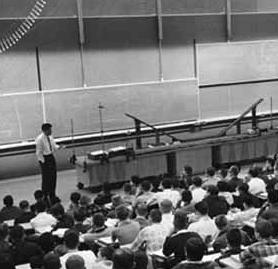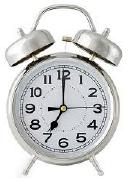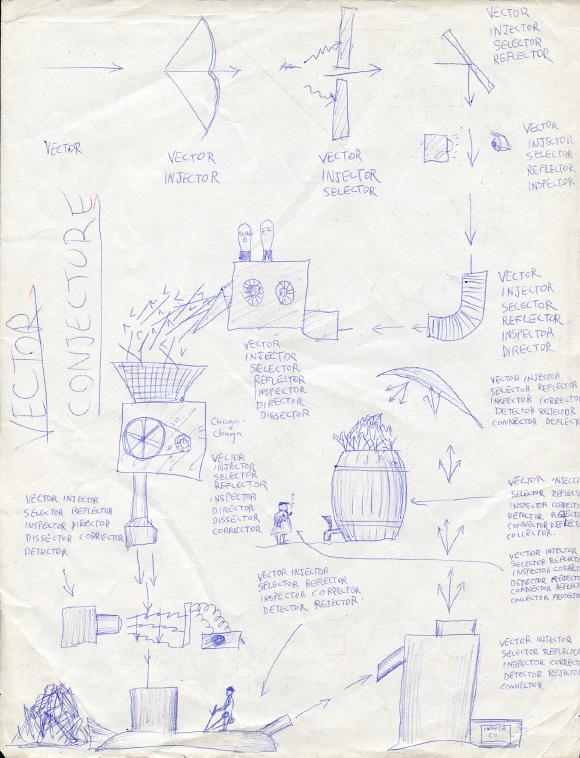
It was there that I was distracted from a lecture one day by watching a nearby student repeatedly falling asleep in his seat. As he dozed off, he slowly leaned forward. Eventually, his forehead hit the desk with a thunk. This woke him up, more or less, and he jerked back into an upright position. But then he immediately began to fall asleep again, gradually slumping forward and repeating the cycle. It was fascinating to watch, sort of like one of those toy birds which uses the cooling effect of evaporation to cause it to dip its beak in and out of a glass of water. Note 2 Many MIT students were chronically sleep deprived. I would occasionally see students in class who had clearly gotten up too late, and raced off to class without getting out of their pajamas. I don't know if the male students of today are less likely to do this, since the student body is now nearly fifty percent women. But back in my day, the students were almost exclusively male. Only 21 women entered in 1959 with the class of 1963, a class of about 900 students. Years later, I was reminded of this oscillating student when I read a column by the great American print humorist Dave Barry. A classic 1989 column of his called "Coping With Anger" contained the selection:
It was easiest to sleep in a lecture hall, where you wouldn't be noticed. Even the head banging student was only noticed by a few people around him. It was a little harder to sleep unobserved in a smaller classroom. I once arrived for a class to find all the students quietly tiptoeing out of the room, along with the instructor of the previous class. I heard the instructor saying something like, "This has never happened to me before." Along with the other students arriving for the next class, I didn't know what was going on until we entered the classroom, and found a student from the previous session sound asleep in his chair. We left him alone, and our instructor started in on our material. The student awoke halfway through our class, looked rather disoriented for a while, and then sheepishly snuck out the door. I was once eating a late breakfast in the Baker house dormitory cafeteria with my friend and fellow classmate Peter Van Aken, when another friend, Martin Schrage, suddenly appeared. Martin looked disheveled and distraught, and said to Peter, "You were supposed to wake me up - I missed my quiz!" Peter replied, "I did wake you up. You told me the quiz had been canceled." Martin said, incredulously, "And you believed me?!!? I'll say anything to avoid waking up in the morning." Peter explained that after being awakened, Martin had sounded completely awake and alert. Peter had apologized to him for waking him up, given that the quiz had been canceled. But Martin had calmly said, "Oh no, I forgot to tell you, you couldn't have possibly known. It's okay." Martin explained his technique for sounding awake when he was in fact ninety percent asleep. It involved making a major effort to over-emote, like a ham actor, imagining that he was speaking loudly, and over-emphasizing every word. When he was in fact mostly asleep, the result, apparently, came across as a wide-awake person speaking in a normal voice. Later that evening I noticed a note on Martin's dormitory door. It said, "Peter, wake me up tomorrow at seven, and don't take any shit." Note 4 So it obviously isn't always easy to wake up a college student. In fact, I found this out one morning in my very first semester in college, when I occupied a triple room in the Baker House dormitory. One of the other occupants and I had arisen, but the third was apparently still sleeping in an upper bunk. I say "apparently", because he couldn't actually be seen, but we assumed the large lump in the blankets was him.
Failing at this, the hand flung the clock across the room, narrowly missing my other roommate. Although the clock kept ringing on the floor, the spring powering the bell eventually unwound, and the ringing stopped. Note 5 If I'd been sharper, the event might have stimulated me to invent the "snooze alarm", a prominent and easy-to-hit button to temporarily silence the alarm for a given interval. There's no reason that couldn't have been implemented mechanically - it didn't have to await the development of the electric alarm clock. But I missed it, possibly missing out on an opportunity for great wealth. And a nice obituary in the Boston Globe - "Lawrence Krakauer, inventor of the snooze alarm". Note 6
Once on the floor, Clocky runs around randomly, making a lot of noise. The alarm continues until you get out of bed, locate it, and shut it off. In theory, by the time you've tracked down Clocky and turned off the alarm, you ought to be fully awake. My involvement with Clocky came about because in retirement, I've been volunteering at MIT's Venture Mentoring Service, abbreviated "VMS". It's "an organization formed to support entrepreneurial activity throughout the MIT community". In my role as a VMS mentor, I've helped a number of entrepreneurial companies get started. Gauri was one of the entrepreneurs advised by a team of VMS mentors. Her company is called Nanda Home. As of May 2012, the Nanda Home page has a nice video on it (although using Clocky as an alarm will not generally cause you to wake up in Paris). As the company grew, I reported on Gauri's progress at multiple VMS meetings. At one of them, a fellow mentor said that he had purchased one for his son, an MIT student. He reported that Clocky worked exactly as advertised, but nevertheless didn't always succeed in waking up his son. His son indeed had to get out of bed and locate Clocky to shut off the alarm. But he would then fall asleep on the floor next to Clocky, wherever it was. I guess some cases of sleep deprivation are worse than others. Note 7 I'll close with another event from room 26-100. This blog entry came about because I recently came across the doodling shown below, scrawled on the back of a political handout (for a student election) that I found in room 26-100 sometime in the early 60s. It had evidently been left by a student attending a previous lecture, who perhaps had been bored by the material being presented. He had instead spent his time drawing the images below, entitled "Vector Conjecture". I've always liked it (which is why I kept it all these years). It's un-signed, so I have no idea who created it, and he didn't even bother to take it with him at the end of the lecture. After rediscovering "Vector Conjecture" in a stack of papers, I started recalling other anecdotes relating to 26-100, and the episode of the head banging student came to mind. This was followed by other stories about sleep deprived students, until I ended up with the blog entry you see above. So "Vector Conjecture" inspired this entry, even though it has nothing to do with sleep. Since I can't think of anywhere else that it fits, here it is anyway. You can click on it, and then click again to enlarge it, if you want to explore it in greater detail. When you're done, return here with your browser's "Back" button: Note 8 Some people doze off, some doodle. These days, students can browse the web on their laptops and smart phones. Is anyone actually listening to the lecture?
  Note 1: MIT's campus is embedded in the city of Cambridge, Massachusetts. All its rooms have numbers, whether they're large halls or broom closets. The numbers are systematically assigned. They start with the building number, followed by a hyphen, followed by the room number within the building. The first digit of the room number generally indicates the floor, and the last two digits of the room number indicate the room on that floor. The building numbers in the central part of the campus have no alphabetic prefix. Buildings to the west of Massachusetts Avenue and south of Vassar Street are prefixed with a "W", and buildings west of Massachusetts Avenue and north of Vassar Street are prefixed with the characters "NW". Similarly, the prefixes "N", "NE", and "E" are used for North, Northeast, and East, respectively. Nothing starts with "S", for South, because that would put it in the Charles River, which separates Cambridge from Boston. You can find a useful interactive map of the campus at http://whereis.mit.edu/. For some reason that I have frankly never understood, non-MIT people seem to find numbered buildings amusing. They seem to feel that major buildings, at least, ought to have names. Well, they do have names, of course. "Building 26", containing the lecture hall pictured at the beginning of this entry, is called the "Karl Taylor Compton Laboratories" or just the "Compton Laboratories" for short. But if you're telling someone where a class is held, or addressing an envelope to an office and sending it through the internal mail system, isn't it easier to use the short designation "26–100"? Why on earth do non-MIT people seem to find a simple and compact numbering system to be somehow funny? It's practical and intelligent. The old photo of 26-100 shown above is from an MIT Museum web page. [return to text] Note 2: If you've never seen one of these, take a look at its Wikipedia entry. [return to text] Note 3: You can see the complete column here. It also later appeared in the book Dave Barry Talks Back. It contains one of my favorite Barry images, that of a dog named Edgar chasing a cat, which (the cat) makes a very sharp right turn, ... "leaving Edgar to run directly, at Dog Warp Speed, into the side of a house. Fortunately, he absorbed the entire impact with his brain, so there was no damage . . ." I own all of Dave Barry's books. [return to text] Note 4: Being from Gainesville, Georgia, Martin lobbied the Baker House nutritionist to serve the southern specialty "grits" for breakfast. She eventually relented, and with great fanfare announced "Grits Day". We all enjoyed the grits, except for Martin, who accidentally slept through breakfast that day. [return to text] Note 5: Spring powered clocks generally had to be wound up every few days, which tightened a spring that powered the mechanism. But a separate spring had to be wound to run the bell - you wound it when you set the alarm. If the alarm didn't have its own spring, allowing the alarm to ring too long would have stopped the clock. [return to text] Note 6: Why not? An obituary in yesterday's Boston Globe announced the death on May 20, 2012 of Eugene Polley, inventor of the first TV remote control. The user pointed a beam of light at a photo cell in each of the four corners of the television screen, each corner activating a different function. In 1955, transistorized electronics didn't exist, so it wasn't that easy to control a television remotely. Polley's device was followed by remotes using different technology. A few years later, Robert Adler developed one that used ultrasonic sound to control the TV. It made the sound by striking short metal bars in the remote. Pushing the buttons made a rather loud clicking noise, which seems to be why TV remotes are to this day sometimes called "clickers" - see the Wikipedia entry on this. [return to text] Note 7: Gauri didn't think much of Clocky when she first created it, until it started, fairly spontaneously, getting an enormous amount of media attention. Apparently, the idea of an alarm clock running away from you and trying to hide was a bit like what I called, in a past blog entry, an "eigenstory", a term originally coined by Professor Marvin Minsky. These are stories that appeal to people, that "tickle their fancy". Gauri found herself being interviewed repeatedly, and appearing on television shows such as "Good Morning America". It didn't hurt that she is articulate, personable, and easy to interview. Coming from an entrepreneurial family, she decided that she had to take advantage of all this free publicity. She formed a company to manufacture Clocky, and made a success of the product. She turned out to be an entrepreneurial dynamo, doing whatever it took to succeed, including traveling to Hong Kong to arrange for manufacturing. Free publicity continued to come her way, and at one point she actually found herself on the cover of Inc. Magazine. You can see that cover, among others, on the Press page of Nanda Home (scroll down a bit). Here's the case-study in Inc., which is a good description of how Nanda Home and Clocky came about. Not all Clocky users are sleep-deprived students, but probably most of them are. [return to text] Note 8: It occurs to me that perhaps not all readers know what a "vector" is. An ordinary number is called "scalar". It possesses only a property called "magnitude". But a vector has not only magnitude, but also direction. Drawn on a piece of paper, a vector is represented by an arrow. Its magnitude is represented by the length of the arrow, and its direction is shown by the way it points.
There are other ways of combining vectors to get other vectors, such as the "cross product", a kind of vector multiplication. But this gets too complicated to be described here. Suffice it to say that doing arithmetic with vectors instead of scalars can often simplify the mathematics in appropriate circumstances. Vector arithmetic is heavily used in physics. [return to text]
 |

 Suddenly, an alarm clock at the head of the bed went off loudly. This was in 1960, and it was a wind-up mechanical clock with an actual bell, one that probably looked something like the one shown to the right. At that, a hand reached out from under the covers, and fumbled with the clock for a second or so, evidently trying to silence the alarm (this was usually done with a lever on the back of the clock).
Suddenly, an alarm clock at the head of the bed went off loudly. This was in 1960, and it was a wind-up mechanical clock with an actual bell, one that probably looked something like the one shown to the right. At that, a hand reached out from under the covers, and fumbled with the clock for a second or so, evidently trying to silence the alarm (this was usually done with a lever on the back of the clock).


 Mathematically, vectors can be added by putting the tail of one at the head of the other, and generating a final vector referred to as the sum, as shown to the right, in which C = A + B. If vector A represents the speed and direction of the current in a river, for instance, and vector B represents the speed and direction of a boat relative to the water, then vector C represents the speed and direction of the boat relative to the shore.
Mathematically, vectors can be added by putting the tail of one at the head of the other, and generating a final vector referred to as the sum, as shown to the right, in which C = A + B. If vector A represents the speed and direction of the current in a river, for instance, and vector B represents the speed and direction of a boat relative to the water, then vector C represents the speed and direction of the boat relative to the shore.